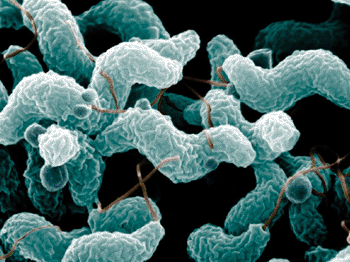Rapid Commercial Test for Campylobacter Evaluated
By LabMedica International staff writers
Posted on 13 Feb 2014
The effectiveness of a new rapid immunochromatographic test for the qualitative detection of Campylobacter antigens in pathologic feces has been evaluated. Posted on 13 Feb 2014
The genus Campylobacter belongs to the family Campylobacteriaceae and contains 18 species, including Campylobacter jejuni, the cause of around 90% of acute Campylobacter enteritis cases in humans, a zoonotic disease prevalent worldwide and transmitted via water and food.

Image: Scanning electron micrograph of Campylobacter jejuni (Photo courtesy of Jonas Waldenström).
Microbiologists at the Hospital Universitario Virgen de las Nieves (Granada, Spain) examined 300 consecutive samples of fresh feces samples from patients diagnosed with diarrhea in primary (57.6%) and specialist (42.4%) care; 50.6% were from adults and 49.4% from children under 14 years of age, between March and May 2013. They were processed for coproculture immediately on their reception by culture and colonies suspected of being enteropathogenic were identified by means of the Biotyper system (Bruker Daltonics; Billerica, MA, USA).
The RIDAQUICK Campylobacter immunochromatographic test (R-biopharm AG; Darmstadt, Germany) was evaluated and compared with culture results. Campylobacter was considered present when the microorganism was isolated or when the specific DNA was detected in samples with contradictory culture and immunochromatographic findings. The results of the RIDAQUICK Campylobacter test was considered positive when violet red lines could be seen in the control (C) and test (T) bands, negative when the control line alone appeared, and invalid when no line could be observed.
Campylobacter was detected in 37 (12.3%) of all samples, and the gold-standard culture method was positive for C. jejuni in 31 (83.78%) of these. A different enteropathogen was detected in 12 (8.11%) of the samples from children. The culture and immunochromatographic results differed in 12 samples (4% of the total), which were therefore studied by polymerase chain reaction (PCR); six of these samples were culture-negative and PCR-positive and one was culture positive (C. jejuni) and PCR-negative.
The diagnostic accuracy values of the RIDAQUICK Campylobacter assay versus culture were: sensitivity of 87%, specificity of 97%, and positive and negative predictive values of 77% and 98%, respectively. RIDAQUICK Campylobacter was found to be a rapid test for the diagnosis of enteritis due to Campylobacter and could be an option for the clinical diagnosis of one of the main causes of bacterial enteritis in resource-limited settings. The study was published in the February 2014 issue of the journal Diagnostic Microbiology and Infectious Disease.
Related Links:
Hospital Universitario Virgen de las Nieves
Bruker Daltonics
R-biopharm AG













